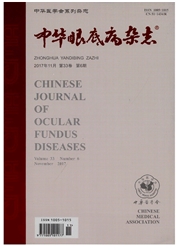

 中文摘要:
中文摘要:
AIM: To compare the effect of cataract surgery in renal transplantation and hemodialysis patients.·METHODS: We evaluated 51 eyes of 31 renal transplantation patients, 41 eyes of 29 hemodialysis patients and 45 eyes of 32 normal control patients who received phacoemulsification and intraocular lens(IOL)implantation from January, 2000 to August, 2014 in the Beijing Friendship Hospital. Each individual underwent a blood routine and a kidney function examination. Routine ophthalmologic examination included best-corrected visual acuity(BCVA), a slit-lamp examination to detect cataract type, determination of intraocular pressure, a corneal endothelial count, and fundus examination. All patients received phacoemulsification and an IOL implantation.·RESULTS: For the types of cataract in the three groups, transplantation group was significantly different from normal control group(P =0.04), the most kind is posterior subcapsular cataract(PSC) in transplantation group 33(64.7%), hemodialysis group had no significantly difference from normal control group(P =0.43), and the difference between transplantation group and hemodialysis group also had significantly difference(P=0.02). For postoperative BCVA in the three groups,transplantation group had significantly difference from normal control group(P =0.03), hemodialysis group was significantly different from normal control group(P =0.00), and the difference between transplantation group and hemodialysis group also had significantly difference(P =0.00). The multiple linear regression equation is Y =0.007 hemoglobin(Hb)-0.000233 serum creatinine(Cr),R2=0.898. Postoperative fundus examination showed that hemorrhage, exudation, and macular degeneration were greater in the hemodialysis group.·CONCLUSION: This study showed that the PSC wasmore in the renal transplantation patients. BCVA was better and fundus lesions were less frequent in the renal transplantation group than in the hemodialysis group after cataract surgery. The multiple linear regression was showed that the Hb was
 英文摘要:
英文摘要:
AIM: To compare the effect of cataract surgery in renal transplantation and hemodialysis patients. METHODS: We evaluated 51 eyes of 31 renal transplantation patients, 41 eyes of 29 hemodialysis patients and 45 eyes of 32 normal control patients who received phacoemulsification and intraocular lens (IOL) implantation from January, 2000 to August, 2014 in the Beijing Friendship Hospital. Each individual underwent a blood routine and a kidney function examination. Routine ophthalmologic examination included best -corrected visual acuity (BCVA), a slit-lamp examination to detect cataract type, determination of intraocular pressure, a corneal endothelial count, and fundus examination. All patients received phacoemulsification and an IOL implantation. RESULTS: For the types of cataract in the three groups, transplantation group was significantly different from normal control group (P=0.04), the most kind is posterior subcapsular cataract (PSC) in transplantation group 33 (64.7%), hemodialysis group had no significantly difference from normal control group (P.:0.43), and the difference between transplantation group and hemodialysis group also had significantly difference (P= 0.02). For postoperative BCVA in the three groups, transplantation group had significantly difference from normal control group (P=0.03), hemodialysis group was significantly different from normal control group (P = 0.00), and the difference between transplantation group and hemodialysis group also had significantly difference (0.00). The multiple linear regression equation is Y= 0.007 hemoglobin (Hb)-0.000233 serum creatinine (Cr), R-2=0.898. Postoperative fundus examination showed that hemorrhage, exudation, and macular degeneration were greater in the hemodialysis group. CONCLUSION: This study showed that the PSC was more in the renal transplantation patients. BCVA was better and fundus lesions were less frequent in the renal transplantation group than in the hemodialysis group after cataract surgery. The multiple linear regression was showed tha
 同期刊论文项目
同期刊论文项目
 同项目期刊论文
同项目期刊论文
 期刊信息
期刊信息
